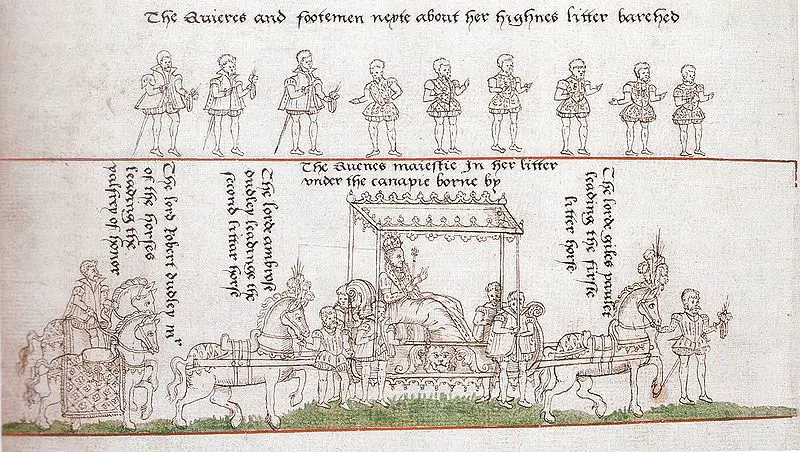 On 15th January 1559, a date chosen by her astrologer Dr John Dee, a triumphant Elizabeth Tudor, daughter of Henry VIII and Anne Boleyn, processed from Westminster Hall into Westminster Abbey to be crowned queen. She was just twenty-five years old, was the third child of Henry VIII to become monarch, and was the longest reigning of them, ruling England for over 44 years.
On 15th January 1559, a date chosen by her astrologer Dr John Dee, a triumphant Elizabeth Tudor, daughter of Henry VIII and Anne Boleyn, processed from Westminster Hall into Westminster Abbey to be crowned queen. She was just twenty-five years old, was the third child of Henry VIII to become monarch, and was the longest reigning of them, ruling England for over 44 years.
Elizabeth's coronation day began in Westminster Hall, which had been decorated with her father's sumptuous tapestries and his collection of gold and gilt plate. Blue cloth had been laid from the Hall to the Abbey, and Elizabeth, wearing her crimson parliament robes, processed along this cloth, which was then torn to shreds by people as souvenirs.
Elizabeth processed to the crossing in the Abbey and withdrew to a curtained enclosure to change. She was then led by Owen Oglethorpe, Bishop of Carlisle, up onto the stage, where he proclaimed her queen in each of the four corners, asking the congregation if they would have her for their queen and listening for their enthusiastic replies of “Yea! Yea!”. Elizabeth then made the traditional offerings at the altar and sat in the throne of estate to listen to the sermon. After the sermon, Elizabeth knelt for the Lord’s Prayer, took the oath, then withdrew to the traverse to change for the anointing part of the service. Wearing a kirtle of gold and silver and leaning on cloth of gold cushions, which had been placed before the altar, Elizabeth was anointed on the shoulder blades, breast, arms, hands and head. She was then dressed in white gloves, a white coif and the white dalmatic (tunic) of a deacon. Now that she had sworn the oath and been anointed, she could sit in St Edward's Chair and receive the sword, armils, mantle, ring and sceptre, and be crowned. She was crowned with three different crowns, one after the other, with fanfares marking each crowning.
Elizabeth was then dressed in gold right down to her shoes, and with the sceptre in one hand and orb in the other, she processed onto the stage where she sat in the throne. There, her people greeted her and Oglethorpe, and the Lords Spiritual and Temporal paid homage to their new queen by kneeling at her feet and kissing her cheek. The coronation pardon was read, and this was followed by the coronation mass, which included the Epistle and the Gospel being read out in both Latin and English. Elizabeth then kissed the Bible. Oglethorpe, defied his new queen by elevating the host, at which point Elizabeth withdrew to change into her purple robes. The Queen then processed from the Abbey, through Old Palace Yard and back to Westminster Hall to enjoy her coronation banquet. Elizabeth was now the official queen, and her coronation and accession had been a huge success.
(Taken from On This Day in Tudor History by Claire Ridgway)



People will have anything to do with royal or famous people. The shirts of football players often get torn to pieces in the melle to get the item when thrown into the crowd, Henry had favors taken off his person during the celebrations of the baptism of his first son, handkerchiefs were dunked in the blood of executed nobles and saints, relics were collected, pilgrimage badges, plus robes from the coronation. Is there any wonder that historic clothing vanished? People love a show as well and the Tudor coronation ceremonies seem to really have given entertainment.